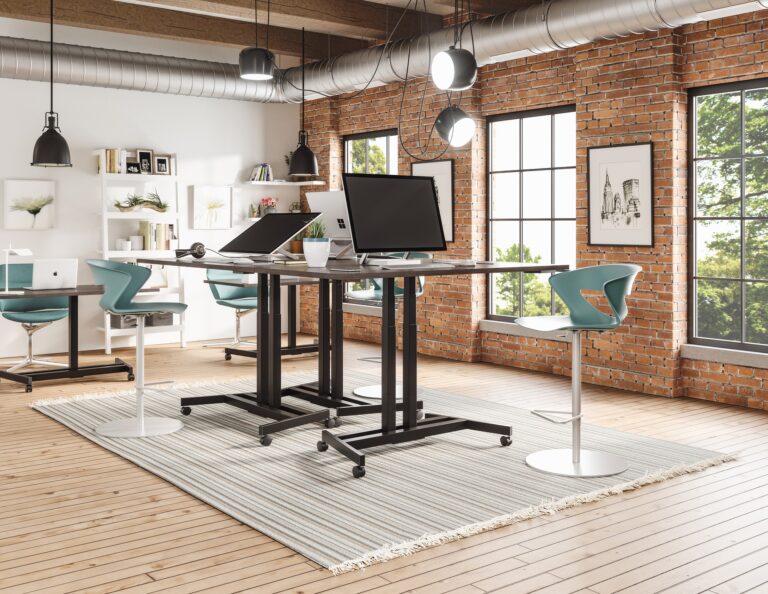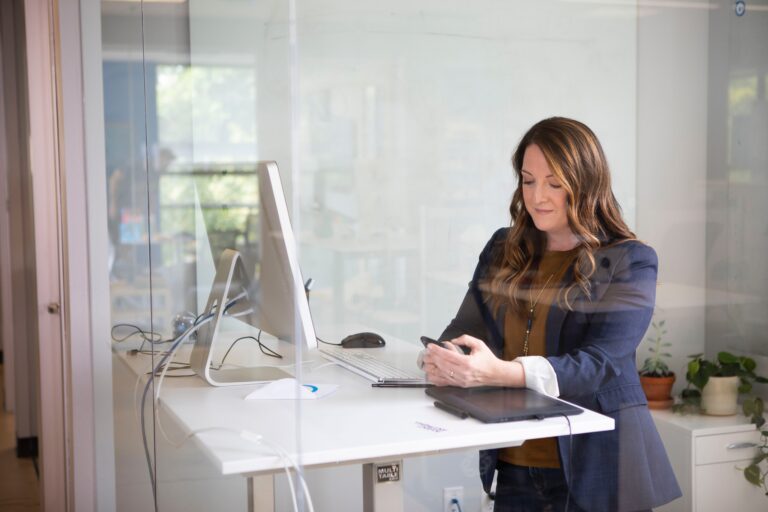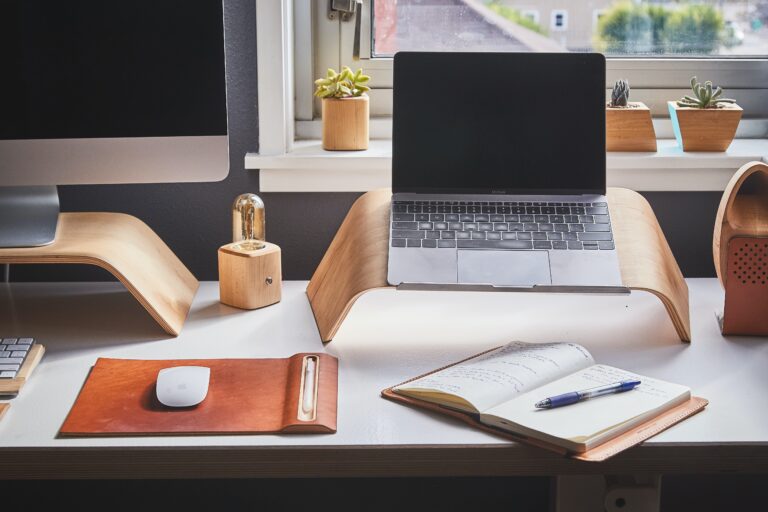Since the COVID-19 pandemic, many of us have been using our homes in ways we’ve never considered before, as they become classrooms and places of learning, offices, gyms and much more. For many of us, that means adjusting to a new way of life – especially if we’re working from home full time.
For some of us, using a dining table desk setup is the best we can do with the space in our home, but how could this be impacting our physical and mental health? In this article, we’ll discuss the potential problems that could occur when using a dining table as a desk, and how you could alleviate some of these issues.
Your home workspace matters
Without a separate workspace in your home, discipline becomes difficult, and you may also find your personal and professional lives slowly blurring into each other. Avoid working from your home kitchen table, bedroom, living room or any other space that you use to relax with family and friends.
While working at the dining room or kitchen table may seem a good idea, it can make your workspace more cluttered and disorganised, with plenty of distractions along the way as other family members use the space. Not only can using the kitchen table at work be bad for your mental health, it can also be physically bad for your body.
Here are a few reasons why working from the kitchen or dining table could be generally bad for you, and why it’s a good idea to have a separate workspace for yourself.
Can working at the kitchen table affect your health?
If you started working from home during the Covid-19 pandemic and you don’t have the space for your own office or a separate ergonomic desk in the corner of a room, chances are you’re still working from your dining room or kitchen table with your company’s laptop equipment and could be feeling the impact of remote working in a physically unsupportive environment.
While a kitchen table makes a great improvised workspace in the short term, over time it can definitely be bad for your body, as your kitchen table isn’t optimised ergonomically. This means increased back pain, posture problems, poor metabolic rate, stress placed on your muscles, and neck or shoulder pain.
Prior to Covid-19, employers in the UK had (and still have) a duty to ensure that all equipment given to office-based workers is properly ergonomic. With millions of office workers sent home to work as a result of the pandemic, many people found themselves having to make the best out of a bad situation, with some very unsupportive ergonomic setups as a result.
Many people have now converted to working from home on a permanent or semi-permanent basis, which means that both staff and employers have to appreciate the importance of ergonomics once again.
How the wrong work setup can affect your body
Musculoskeletal disorders are the leading cause of pain in American workplaces, according to the US Department of Labor. This costs US employers $50bn a year in lost productivity.
The situation is no different in the UK. According to the Health and Safety Executive, in 2021/22, 477,000 workers suffered from a musculoskeletal disorder, and 1.8 million people suffered from a work-related illness. [1]
Long-term muscle and joint pain caused by sitting at an unsuitable desk can eventually lead to mental health problems if you are experiencing pain on a daily basis. 18% of workers reported having suffered from depression in the last three years due to ailments associated with a poor quality desk setup. [2]
Dining table ergonomics
Great importance was once placed on having ergonomic chairs and desks in the office for sedentary workers, and standing desks became popular as switching between sitting and standing all day is far better for a worker’s health.
Because many workers are now remote, companies may send out laptops, but they also need to ensure they are offering equipment to give employees ergonomically designed workstations at home. This means offering items like:
- A keyboard tray
- Anti-fatigue mat
- Ergonomic chair
- Adjustable monitor arm
These items ensure that workers are not placing extra strain and pressure on their bodies by working at their kitchen tables that are not designed for long-term office use.
How employers are affected
While some companies may consider it cheaper to make it workers’ responsibility to arrange their own WFH setup, there is also a cost to employers if they do nothing, and don’t offer a safe and ergonomic working environment. Gone are the days when an employee was fully responsible for their work-from-home setup, especially if they were fully remote, full-time.
Severe carpal tunnel claims in the UK can reach up to £20,000, which is a huge cost to a company for a condition that can be prevented with a good quality and supportive keyboard tray, keyboard and mouse.
If workers are switching from ergonomic workstations in the office to using a dining table as a desk at home, it’s only a matter of time before muscular pain starts to set in. Staff need to make sure they have a designated, ergonomically suitable space for work, and employers need to consult with HR departments and insurance underwriters to revise how they source and send equipment to workers to avoid future claims for stress and musculoskeletal problems.
Google, for instance, gives workers up to $1,000 each in reimbursements for any needed office furniture. This is a route many companies will need to pursue, or we risk having a generation of workers with health issues as they continue to work from their kitchen tables.
Problems with working at the dining table
When the Covid-19 pandemic forced many people to work from home, this came without notice, causing many people to create makeshift setups in order to create some kind of office space to work in. This meant lots of people using home furniture like dining and kitchen chairs to try to accommodate work life. While the furniture being used may seem like a trivial detail, it’s actually very important for our well-being.
Office equipment is often taken for granted, but there is a point to ergonomic office chairs and adjustable desks. They make us more comfortable and ensure that our back, neck, arms and hands are properly supported when working and sitting at a desk for long periods of time.
Some people are lucky enough to have a home office – a room all to themselves that they can designate solely for work. For others, it isn’t that easy, meaning that working on a laptop happens in the kitchen, dining room, or even on the sofa or in bed. Sitting scrunched over in an unsupported position like this can really take its toll on our posture, spine and back muscles.

Ensuring good posture while sitting down for work will prevent future health issues and musculoskeletal problems in later life. While it may be appealing to roll out of bed in the morning and commute downstairs to the dining room table, not having a designated workstation that is in line with correct health and safety guidelines is very bad for your health. Here are some other problems with working at the dining table.
No work-life boundaries
When you mix work and private life, it becomes very difficult to separate the two. You might be tempted to check your work email in your spare time, or may lose track of time and end up working past your finishing time (giving your employer more work time for free).
If you use the same table for working that you do for coming together with your family and eating, it is very difficult to separate professional and personal boundaries. This can sometimes contribute to work-from-home fatigue or ‘Zoom fatigue’.
You’re not getting as much exercise
If you’re not commuting to an office, it’s likely you’ll be getting less exercise than a person who does. Getting up out of bed, and then working and eating at the same kitchen or dining table in your home is a habit that makes you more sedentary, and you miss out on the benefits of regular exercise.
It becomes tempting to work while eating, which is a poor habit to get into, as it encourages a lack of exercise and discourages taking breaks, which are vital for your neck and back, legs and circulation. If you can, try to use a standing desk, or do standing exercises throughout the workday to stay moving.
Distractions at home
If you live with other people, especially young children, working in your living space can be challenging at the best of times. But if you decide to work at your kitchen table, you’re putting yourself at risk from chatter and noise, people interrupting your video calls and breaking your focus. Give yourself a workspace that is just for you, as this will cause you less stress in the long run.
Back, posture and spine problems
Kitchen and dining chairs lack the lumbar and adjustable support of ergonomic office chairs, making them very uncomfortable when sitting for long periods, as they have very little flexibility. If you’re sitting hunched over your kitchen table, staring at a laptop for eight hours a day, this is also going to cause discomfort in your back and neck.
One study found that 80% of employees reported suffering ailments as a result of sitting at an unsuitable desk while working at a computer, with workers spending an average of 6.5 hours per day at their desks. [1]
Your monitor for instance should be at eye level. When working on a laptop, it can cause you to bend your neck and shoulders forwards as you look down at your screen. This can place unnecessary pressure on your neck muscles.
How to protect your posture when working from home
Whether you’re a fully remote worker or have a hybrid pattern, here are some top tips to protect your back, shoulders and neck while working at a desk for long periods.
- Use an adjustable ergonomic chair and adjust your seat when you feel you need to.
- Avoid slouching and check-in with your posture every 15 minutes. Readjust if you need to.
- Get up from your seat, stretch and move around every 30 minutes – even if it’s just for a toilet or coffee break.
- Keep everything that you need at arm’s length to prevent straining.
- Stay hydrated.
- Eat somewhere else in the home that isn’t at your desk.
Stretch to keep your muscles moving and to create good posture.
Sources
- https://hcssafety.co.uk/news/hse-health-and-safety-at-work-stats-for-2021-2022
- https://hrreview.co.uk/hr-news/wellbeing-news/an-office-chair-lead-to-mental-health-problems/51711





